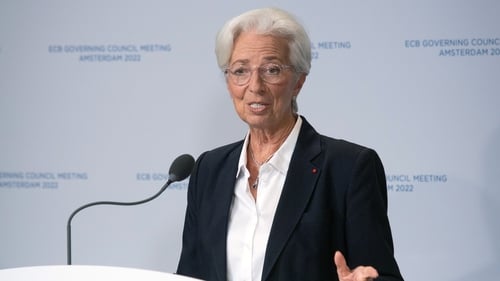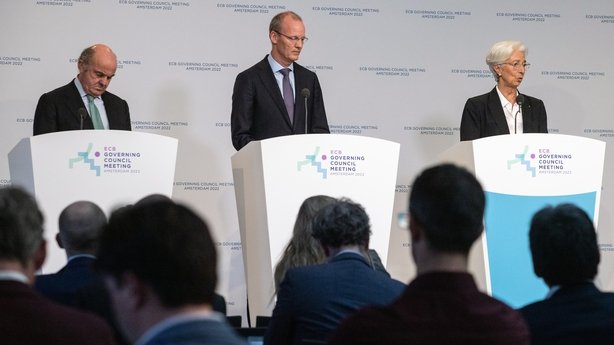ECB to raise interest rates by 0.25% in July, and end bond-buying programme

The European Central Bank has ended a long-running stimulus scheme and signalled it will deliver its first interest rate hike since 2011 next month, followed by a potentially larger move in September if inflation does not cool down.
With inflation at a record-high 8.1% and still rising, the ECB now fears that price growth is broadening out and could morph into a hard-to-break wage-price spiral, heralding a new era of stubbornly higher prices.
The central bank for the 19 countries that use the euro said it will end bond buys on 1 July then raise interest rates by 0.25% later that month.
It will hike again in September and may opt for a bigger move – a 50 basis point hike that would be its largest one-off increase since June 2000.
“We intend to raise the key ECB interest rates by 25 basis points at our July monetary policy meeting,” says ECB President Christine Lagarde.
“We will make sure that inflation returns to our 2% target over the medium term,” ECB President Christine Lagarde said during a news conference.
“It is not just a step, it is a journey,” she said of the moves signalled today.
The rapid rise in inflation was driven initially by energy and food prices as economies emerged from Covid-19 lockdowns but Russia’s invasion of Ukraine has accelerated those trends.
The size of rate hikes to curb price growth has been intensely debated by ECB policymakers, with Chief Economist Philip Lane preferring 25-basis-point moves in July and September but others arguing for 50 bps to be considered.

Supporting their case, the ECB raised its inflation projections once again, now expecting inflation at 6.8% this year versus a previous forecast for 5.1%.
In 2023, it sees inflation at 3.5% and in 2024 at 2.1%, indicating four straight years of inflation overshoots.
“The Governing Council anticipates that a gradual but sustained path of further increases in interest rates will be appropriate,” the ECB’s monetary policy statement said.
“High inflation is a major challenge for all of us.”
Markets moved to price in 143 basis points of rate hikes by the end of this year following the statement, up from 138 bp earlier, or an increase at every meeting from July, with some of the moves in excess of 25 basis points.
They are also anticipating a combined 230 basis points of moves in the deposit rate by the end of 2023, putting the interest rate peak close to 2%.
That left Ms Lagarde, who just months ago said that a rate hike this year was highly unlikely, in a tricky position at her news conference.
Nevertheless she showed little hesitancy, underscoring a number of times how the bank planned to gradually hike its rates at upcoming meetings.
She also vowed not to allow the borrowing costs of former euro zone debt crisis countries to be pushed wildly higher by financial markets again. “We are committed, committed!” Ms Lagarde said.
The ECB’s first rate hike in over a decade will still leave it trailing most of its global peers, including the US Federal Reserve and the Bank of England, which have been raising aggressively and promising even more action.
Unlike the Fed, the ECB also has no plans to reduce its balance sheet with policymakers reaffirming their commitment to keep reinvesting cash maturing from the 5 trillion euros worth of public and private debt the ECB holds.
Where does it end?
Ms Lagarde has said that rates should move towards the neutral point at which the ECB is neither simulating nor holding back growth.
But this level is undefined and unobservable, leaving investors guessing just how far the ECB wants to go.
Another question is how the ECB will handle the divergence in borrowing costs of various member states, an issue the ECB said it may address but did not mention in Thursday’s policy statement.
Nations with bigger debt piles, such as Italy, Spain and Greece, have already seen yields on their government bonds rise more sharply than less-indebted Germany or France – a headache for the ECB’s one-size-fits-all monetary policy.
